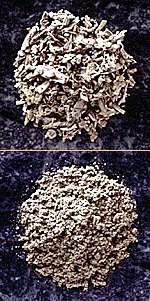
Sage
General Description
Sage is an herb from an evergreen shrub, Salvia officinalis, in the mint family. Its long, grayish-green leaves take on a velvety, cotton-like texture when rubbed (meaning ground lightly and passed through a coarse sieve).
Geographical Sources
Sage is grown in the United States. It also is grown in Albania, Montenegro, Bosnia and Serbia.
Traditional Ethnic Uses
Sage enhances pork, lamb, meats, and sausages. Chopped leaves flavor salads, pickles, and cheese. It is one of the most popular herbs in the United States.
Taste and Aroma Description
Sage has a fragrant aroma and an astringent but warm flavor.
History/Region of Origin
The name "Sage" comes from the Latin word salia, meaning to save. Greeks and Romans used it to cure snake bites and to invigorate the mind and body. In the Middle Ages, people drank Sage in tea and used Sage to treat colds, fevers, liver trouble, and epilepsy. Although Sage is no longer used medicinally, it has become one of the world's most popular herbs.
Storage Tips
Store in cool, dark, dry places.
A Few Ideas to Get You Started
Crumble leaves for full fragrance. Use ground Sage sparingly; foods absorb its flavor more quickly than leaf Sage. Sage is a wonderful flavor enhancer for seafood, vegetables, breadsticks, cornbreads, muffins, and other savory breads. Top swordfish, tuna, steaks, chicken, and turkey pieces with Sage-lemon butter. Rub Sage, cracked pepper, and garlic into pork tenderloin or chops before cooking.
